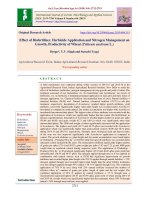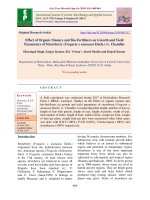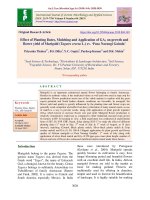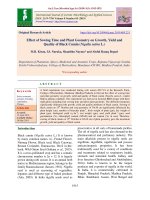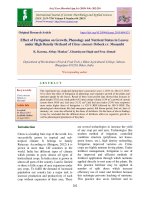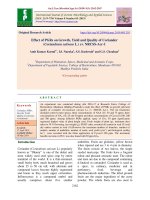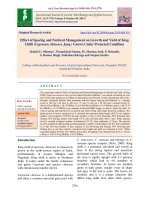Effect of pruning and drip fertigation on growth parameters of guava (Psidium guajava L.) cv. Sardar
Bạn đang xem bản rút gọn của tài liệu. Xem và tải ngay bản đầy đủ của tài liệu tại đây (273.2 KB, 7 trang )
Int.J.Curr.Microbiol.App.Sci (2018) 7(8): 65-71
International Journal of Current Microbiology and Applied Sciences
ISSN: 2319-7706 Volume 7 Number 08 (2018)
Journal homepage:
Original Research Article
/>
Effect of Pruning and Drip Fertigation on Growth Parameters
of Guava (Psidium guajava L.) cv. Sardar
A. Mahadevan1*, S. Kumar2, V. Swaminathan3, A. Gurusamy4 and T. Sivakumar5
1
Department of Horticulture, Krishna College of Agriculture and Technology, Srirengapuram,
Usilampatty, Madurai, Tamil Nadu 625532, India
2
Department of Horticulture, Anbil Dharmalingam Agricultural College and Research
Institute, Trichy, Tamil Nadu 620 009, India
3
Horticulture College and Research Institute, Periyakulam, Tamil Nadu 625604, India
4
Department of Agronomy, 5Department of Crop Physiology, Agricultural College and
Research Institute, Madurai, Tamil Nadu 625104, India
*Corresponding author
ABSTRACT
Keywords
Guava (Psidium
guajava L.) cv.
Sardar, RDF,
Fertigation
Article Info
Accepted:
04 July 2018
Available Online:
10 August 2018
The guava botanically Psidium guajava belongs to family of myrtaceae. Guava was
considerate to be one of the most exquisite and nutritionally valuable remunerative crop. It
was originated in tropical America. The present investigation was conducted on “Effect of
pruning and drip fertigation on growth parameters of Guava (Psidium guajava L.) cv.
Sardar” at Farmers Field, Devathanapatti, Theni (Dt), Tamil Nadu. The field experiment
was laid out in Factorial Randomized Block Design (FRBD) replicated thrice with two
factors (Factor 1- Pruning, Factor 2- Fertigation), i.e., different pruning levels viz., P0 Without pruning, P1 - Light pruning (removal of past season growth up to 15 cm), P 2 Moderate pruning (removal of past season growth up to 30 cm) and drip fertigation levels
viz., F0 - 100 per cent recommended dose of fertilizer (RDF) as soil application and
irrigation, F1 - 125 per cent RDF through fertigation, F2 - 100 per cent RDF through
fertigation, F3 - 75 per cent RDF through fertigation, F4 - 50 per cent RDF through
fertigation. The results of the investigation revealed that the morphological characters were
significantly influenced by different pruning levels and drip fertigation treatments. Among
the different pruning levels, P2 - moderate pruning (removal of past season growth up to 30
cm) increased the tree height, tree spread, fresh weight of pruned branches and number of
new shoots emerged from pruned branches and shoot length resulting with earlier
flowering in rainy season.
due to its low cost of production and high
nutritional value. In India, it is cultivated in an
area of 0.23 million hectares with an annual
production of 3.19 million tonnes and
productivity of 13.6 t ha-1 and stands fourth
place among the major tropical fruits. In Tamil
Introduction
Guava (Psidium guajava L.), is one of the
most important fruit crops cultivated widely in
tropical region of the world and considered as
„poor man‟s apple‟ or „the apple of tropics‟
65
Int.J.Curr.Microbiol.App.Sci (2018) 7(8): 65-71
Nadu, the area is about 0.0079 million
hectares with production of 0.0978 million
tonnes (NHB, 2013). The guava is almost
cultivated in all the districts of Tamil Nadu
with more area being concentrated in
Dindigul, Madurai, Virudhunagar and Theni
districts which have many factors for low
productivity. Lot of scopes for increasing area
under guava cultivation in Tamil Nadu in the
years to come due to its demand from the
consumers.
spacing adopted was 6 x 6 m with a plant
population of 277 plants ha-1. The experiment
was laid out with five levels of NPK in
factorial randomized block design and
replicated three times. In guava, there are
three main seasons of flowering known as
Ambe bahar (Feb - March), Mrig bahar (June July) and Hasta bahar (October).
The main feature of crop regulation was based
on seasonal and marketable demand. In this
experiment, Ambe bahar (February - March)
and Mrig bahar (June - July) flowering
seasons were taken for research trials and
observations were recorded.
Among the many hurdles, non-adoption of
canopy management is one of the reasons for
low productivity in Tamil Nadu. Guava grows
luxuriantly and produces abundant foliage due
to its evergreen habit under tropical condition.
Hence, proper training and pruning is essential
to harness the sunlight vis a vis with higher
productivity.
The treatment combination P0F0 - Control
(Without pruning + Soil application of 100 %
RDF), P0F1 - Without pruning + 125 % RDF
through fertigation, P0F2 -Without pruning +
100 % RDF through fertigation, P0F3 -Without
pruning + 75 % RDF through fertigation, P0F4
- Without pruning + 50 % RDF through
fertigation, P1F0 - Removal of past season
growth up to 15 cm (Light pruning) + Soil
application of 100 % RDF, P1F1 - Removal of
past season growth up to 15 cm (Light
pruning) + 125 % RDF through fertigation,
P1F2 - Removal of past season growth up to 15
cm (Light pruning) + 100 % RDF through
fertigation, P1F3 - Removal of past season
growth up to 15 cm (Light pruning) + 75 %
RDF through fertigation, P1F4 - Removal of
past season growth up to 15 cm (Light
pruning) + 50 % RDF through fertigation,
P2F0 - Removal of past season growth up to 30
cm (Moderate pruning) + Soil application of
100 % RDF, P2F1 - Removal of past season
growth up to 30 cm (Moderate pruning) + 125
% RDF through fertigation, P2F2 - Removal of
past season growth up to 30 cm (Moderate
pruning) + 100 % RDF through fertigation,
P2F3 - Removal of past season growth up to 30
cm (Moderate pruning) + 75 % RDF through
fertigation and P2F4 - Removal of past season
growth up to 30 cm (Moderate pruning) + 50
% RDF through fertigation.
The main objective of training in guava is to
produce a strong framework and scaffolding
branches suitable for bearing a remunerative
crop in the years to come (Anon, 1999).
Guava growers in Tamil Nadu rarely do a
systematic nutrient management practice.
Fertigation enables adequate supply of water
and nutrients with precise manner and uniform
distribution to meet the crop nutrient demand.
Further, fertigation ensures substantial savings
in fertilizer and water usage which reduce the
leaching losses (Kumar et al., 2007). Frequent
application of water and optimum split
application of fertilizers in the form of
fertigation improve the quality and quantity of
crop yield than the conventional practice. In
this connection, there is a need to adopt the
precise nutrient application coupled with
canopy management strategies for higher yield
and quality of guava in Tamil Nadu.
Materials and Methods
The present experiment was carried out in ten
years old guava trees of cv. Sardar. The
66
Int.J.Curr.Microbiol.App.Sci (2018) 7(8): 65-71
with the higher productivity. Training and
pruning of guava trees has been found to
improve the yield and quality and provide a
strong framework, Scaffolding branches are
suitable for bearing a remunerative crop.
Guava growers in Tamil Nadu rarely do a
systematic nutrient management program.
Most of them apply only FYM or poultry
manure once a year after summer harvest.
Tree height
Tree height was measured from the ground
level to growing point before pruning and
after harvest and expressed in metres.
Tree spread
The spread of the tree (East to West and North
to South) was measured using measuring tape
in three stages before pruning, after pruning
and after harvest and expressed in metre.
However, TNAU recommends a fertilizer dose
of 1.0kg in each of N, P and K per tree per
year (Anon, 1999) and fertigation through drip
system is not adopted by farmers in Tamil
Nadu.
Fresh weight of pruned branches
The fresh branch removed from each tree at
the time of pruning was taken and the value
was expressed in kilograms.
The tree height showed a linear trend of
growth in all the treatments during rainy
season of the study. Among the treatments,
moderate pruning (30 cm) and application of
125 per cent RDF as WSF through fertigation
recorded the highest value of plant height
during rainy season while the lowest value
was recorded by control (Table 1).
Number of new shoots emerged from
pruned branches
The total number of current season branches
which emerged was recorded in three trees per
replication and the mean value was expressed
in number.
It has already been established that nitrogen,
being an important constituent of chlorophyll,
proteins and amino acids, promoted the
photosynthetic efficiency of the plant system
when applied at sufficient quantities (Pafli,
1965) higher rate of increase in plant height
during rainy season is obvious due to the
perennial nature of tree growth and the
nutrients added in the first year which would
have helped in assimilation of reserves in the
plant leading to desirable results in the
subsequent season in mango (Sivakumar,
2007).
Shoot length
On the four marked branches, one on each
side of the tree, five healthy shoots along with
flower bud were tagged. The length of all the
shoots were measured with the help of
measuring tape and expressed in cm.
Statistical Analysis
The statistical analysis of data was done by
adopting the standard procedures of Panse and
Sukhatme (1985)
The different level of pruning and fertigation
treatments moderate pruning (30 cm) and
application of 125 per cent RDF as WSF
through fertigation recorded the increased the
fresh weight of the pruned branches in rainy
season (Table 2).
Results and Discussion
In guava trees are training and pruning is
essential to harness the sunlight concomitant
67
Int.J.Curr.Microbiol.App.Sci (2018) 7(8): 65-71
Table.1 Effect of pruning and fertigation levels on tree height (m) of guava cv. Sardar at
vegetative stage
Pruning
Fertigation
Rainy season
P0
P1
(No
Light
pruning)
Pruning
(15 cm)
P2
Moderate
pruning
(30 cm)
Mean
F0 (Control)
F1 (125% of RDF)
F2 (100% of RDF)
1.79
2.21
2.15
1.89
2.45
2.39
1.95
3.09
2.98
1.88
2.58
2.51
F3 (75% of RDF)
2.09
2.35
2.82
2.42
F4 (50% of RDF)
Mean
2.00
2.05
2.22
2.26
2.67
2.70
2.30
SEd
CD at 5%
P
F
P×F
0.06
0.12
0.04
0.09
0.07
0.14
Table.2 Effect of pruning and fertigation levels on fresh weight of the pruned branches
(kg/plant) of guava cv. Sardar
Pruning
Fertigation
Rainy season
P0
P1
(No
Light
pruning)
Pruning
(15 cm)
P2
Moderate
pruning
(30 cm)
Mean
F0 (Control)
F1 (125% of RDF)
F2 (100% of RDF)
0
0
0
14.21
18.93
17.67
15.60
26.19
23.95
14.91
22.56
20.81
F3 (75% of RDF)
0
16.93
22.37
19.65
F4 (50% of RDF)
Mean
0
0
16.42
16.83
21.86
21.99
19.14
P
F
P×F
SEd
0.48
0.53
0.43
CD at 5%
0.96
1.06
0.87
68
Int.J.Curr.Microbiol.App.Sci (2018) 7(8): 65-71
Table.3 Effect of pruning and fertigation levels on canopy spread (m) of guava cv. Sardar at
vegetative stage
Pruning
Fertigation
Rainy season (N-S)
P0
P1
(No
Light
pruning)
Pruning
(15 cm)
P2
Moderate
pruning
(30 cm)
Mean
F0 (Control)
F1 (125% of RDF)
F2 (100% of RDF)
2.44
2.70
2.65
2.52
2.84
2.81
2.55
3.05
3.00
2.50
2.86
2.82
F3 (75% of RDF)
2.61
2.76
2.94
2.77
F4 (50% of RDF)
Mean
2.57
2.59
2.72
2.73
2.89
2.88
2.73
SEd
CD at 5%
P
F
P×F
0.06
0.13
0.07
0.15
0.05
0.10
Table.4 Effect of pruning and fertigation levels on number of new shoot emerged from pruned
branches of guava cv. Sardar
Pruning
Fertigation
Rainy season
P0
P1
(No
Light
pruning)
Pruning
(15 cm)
P2
Moderate
pruning
(30 cm)
Mean
F0 (Control)
F1 (125% of RDF)
F2 (100% of RDF)
0
0
0
5.42
8.17
7.84
6.92
11.79
10.36
6.17
9.98
9.10
F3 (75% of RDF)
0
7.52
9.14
8.33
F4 (50% of RDF)
Mean
0
0
7.11
7.21
8.60
9.36
7.86
SEd
CD at 5%
P
F
P×F
0.22
0.45
0.18
0.37
0.21
0.41
69
Int.J.Curr.Microbiol.App.Sci (2018) 7(8): 65-71
Table.5 Effect of pruning and fertigation levels on shoot length (cm) of guava cv. Sardar
Pruning
Fertigation
F0 (Control)
F1 (125% of RDF)
F2 (100% of RDF)
F3 (75% of RDF)
F4 (50% of RDF)
Mean
Rainy season
P0
P1
(No
Light
pruning)
Pruning
(15 cm)
0
17.01
0
21.01
0
19.64
0
19.15
0
18.74
0
19.11
SEd
CD at 5%
P
0.51
1.02
The result is in line with findings of Howared
Wuertz et al., (2000) who observed that drip
fertigation at frequent intervals provides a
consistent moisture regimes and nutrient pool in
the soil and therefore, roots remain active. The
proper and continuous moisture in the soil also
increases the availability of nutrients and
translocation of food materials which accelerate
the vegetative growth of plant and maintain the
micro climate of the crop at optimum level in
guava.
F
0.46
0.91
P2
Moderate
pruning
(30 cm)
18.01
24.89
22.03
21.56
21.06
21.51
Mean
17.51
22.95
20.83
20.35
19.9
P×F
0.56
1.12
are of considerable biological importance;
similar results were supported by Bhobia et al.,
(2005) in guava.
The shoot length showed a linear trend of
growth in all the treatments with slight
increment during rainy season. Among the
treatments, moderate pruning (30 cm) and
application of 125 per cent RDF as WSF
through fertigation recorded the highest values
of shoot length during rainy season while the
lowest values were recorded by control (Table
4). It may be due to the application N and K
nutrients have specific role on the apical
meristematic
tissue
of
main
shoot,
multiplication and differentiation process. Thus
it paved the way for sprouting of discs and
auxiliary buds which in turn gave raise to tillers
(Yadav, 1991). Similar results were also
reported by Mahendran et al., (2005) and
Dhanalakshmi (1999) under drip fertigation in
sugarcane.
The new shoot emergence per branches showed
a linear trend of growth in all the treatments
during rainy season. Among the treatments,
moderate pruning (30 cm) and application of
125 per cent RDF as WSF through fertigation
recorded the highest values of new shoots
emergence during rainy season (Table 3). It
may be due to the application nitrogen
concomitantly which could increase vegetative
growth and also might be attributed by increase
in proteins and carbohydrates levels. Similar
observation were made by Hillman and Galston
(1961). Also increased nitrogen levels caused
an increased meristemtic activity (Arney, 1951).
Moreover, nitrogen is an important component
of proteins, amino acids and co-enzyme which
The canopy spread showed a linear trend of
growth in all the treatments during both the
season of the study. Among the treatments,
moderate pruning (30 cm) and application of
125 per cent RDF as WSF through fertigation
70
Int.J.Curr.Microbiol.App.Sci (2018) 7(8): 65-71
recorded the highest values of canopy spread
during rainy season while the lowest values
were recorded by control (Table 5). It may be
due to the application of nutrients and moisture
at the appropriate time i.e rapid growth phase,
which could have increased the canopy spread.
Similar results were also reported by
(Ramniwas et al., 2012) in guava.
On-Farm Responses and Technical
Advances. Drip irrigating of row crops
conducted on Nov. 9. In: Las Cruces,
New Mexico.
Kumar, A., R. K. Singh A. K. Sinha, H. K.
Singh and A. P. Mishra. 2007. Effect of
fertigation on banana through drip
irrigation in North Bihar. J. Res. Birsa
Agric. Univ., 19:81-86.
Mahendran. S., S. Ramanathan, A. C. Prabagar,
J. Stephen Arul, P. Rajarathinam and R.
Yeyasrinivas. 2005. Drip and fertigation
for higher cane yield. 37th Meeting of
sugarcane research and development
workers of Tamil Nadu. Rajshree sugars
and chemicals Ltd., Theni district. August
26th and 27th.
Pafli, G. 1965. Relations between abundant N
supply and amino acid concentration in
leaves of rice plants. Plant and Soil, 23:
275 - 284.
Panse, V. G and P. V. Sukhatme. 1985.
Statistical Methods for Agricultural
Workers. ICAR, New Delhi.
Ramniwas, R.A. Kaushik and D. K. Sarolia.
2012. Response of irrigation and
fertigation scheduling on flowering,
physiological parameters and fruit yield
of guava (Psidium guajava L.) under high
density planting. Ann. Agric. Res. New
Series vol.33 (3): 115-120.
Sivakumar, V. 2007. Studies on influence of
various nutrient levels applied through
fertigation on growth, physiology, yield and
quality of mango (Mangifera indica L.) cv.
Ratna under high density planting. Ph.D.
(Hort.) Thesis, Tamil Nadu Agri. Univ.,
Coimbatore.
Yadav, R. L. 1991. Sugarcane production
technology constrains and potentialities.
Oxford and IBH Pub. New Delhi.
Hence the present investigation clearly indicates
that in moderate pruning (30 cm) and
application of 125 per cent RDF as WSF
through fertigation, the soil N and P content in
fertigation treatments were higher in vegetative
stage.
References
Anon.1999. Guava. Crop production techniques
of Horticultural crops: 21-23.
Arney, S. E. 1952. Some effects of nitrogen
nutrients on the morphological and
anatomy of narrow stem kale. Ann. Appl.
Biol., 39: 226-76.
Bhobia, S., K. Godara, S. Sukhbir, L. S.
Beniwal and S. Kumar. 2005. Effect of
organic and inorganic nitrogen yield and
NPK content of guava cv. Hisar Surkha
during winter season. Haryana J. Hort.
Sci., 34 (3-4): 232-233.
Dhanalakshmi, M. 1999. Effect of crop
geometry, drip and fertigation on yield
and quality of sugarcane. M.Sc. (Ag.)
Thesis.
Agricultural
College
and
Research Institute (TNAU). Madurai,
Tamil Nadu.
Hillman, W. S and A.W. Galstone. 1961. The
effect of external factors on auxin
content.
Encyclopedia
of
Plant
Physiology.
Howard Wuertz, Sundance Farms and
Ariz.2000. Subsurface Drip Irrigation:
How to cite this article:
Mahadevan, A., S. Kumar, V. Swaminathan, A. Gurusamy and Sivakumar, T. 2018. Effect of
Pruning and Drip Fertigation on Growth Parameters of Guava (Psidium guajava L.) cv. Sardar.
Int.J.Curr.Microbiol.App.Sci. 7(08): 65-71. doi: />
71
